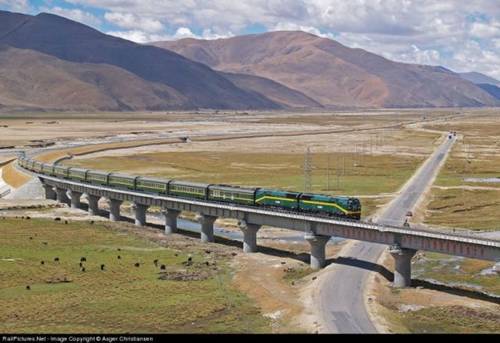The Qingzang Tibet Railway
The Qingzang Railway (also known as Qinghai-Tibet Railway) is the world’s highest railway and a culmination of the long-held Chinese dream of connecting China to Tibet. This railway line was built to ease the travel and to also provide a passageway for minerals from Tibet to the Chinese mainland. The average elevation of this bridge is between 3000 and 4000 meters above the sea level. Some of the highest mountains rise out of this region and the area is fenced by snowy mountains that Tibetans sometimes refer to as ‘the land of snows’.
Given the high altitude and the unforgiving the terrain, the The Qingzang is an engineering wonder in its own right. Construction began in 1958 and was open to traffic in 1984. Much of the construction work was done by prisoners. However due to due to the inadequacy of technologies required to build a railroad in such a climatically and geographically challenging region and the lack of funding at the time it stopped in Golmud. It was used exclusively by the army until 1984 when it was opened to the public. It was not until 2001 that work began on the final 1,142 kilometers to Lhasa.

Challenges
Work on the remaining section of the Qinghai -Tibet Railroad resumed on June 2001 as an important project in the Western Development campaign. The main aim was to bridge the growing social, economic and developmental gaps between the coastal east and the landlocked west in China. Engineers carried out an in-depth analysis of the railway building technology on permafrost, ecological environment protection, labor and hygiene. The project took up the permanent employment of 67,000 Chinese technicians and workers and another 16,000 workers seasonally employed locally. The project cost over $3.5 billion and was opened to the public on July 1, 2006.
Engineers faced a number of unique challenges while working on the Qingzang Tibet Railway. To start off, they had to deal with the permafrost in the region. While the soil would remain frozen during the cold seasons, it thawed and the ice would melt during the summer. There were numerous landslides and in some places the ground would move up or down by a meter within the year. Engineers were faced with two options: remove the top soil with water content, cool down the soil below the railway and insulate it from summer heat or build the railway on bridges rooted deeply below the thawing layer. Finally, engineers tackled the problem by constructing elevated tracks and causeways over some of the most difficult terrain, while in other areas pipes were installed to circulate liquid nitrogen below the rail bed to keep the ground frozen.
Another major hindrance was the high altitudes that the workers had to face. Typically, the thin air in high altitudes would make anyone get tired faster. Thus workers would only work six hours in a day and medical stations were positioned close by. Additionally, special oxygen facilities were provided for the workforce. The weather was quite harsh and lack of vegetation led to frequent sand and dust storms. There were also areas that were prone to earthquakes.
Setting up a steady and reliable signaling and communication system in such harsh environments and over a long distance was a major hurdle. Engineers could not guarantee a constant supply of electricity and finally an assistant solar power supply system was installed. It comprised nine solar power supply stations, with a gross capacity of 122.4 kilowatts and a further seven supply stations were placed along the length of the railway.
Features
The Qingzang Tibet Railway stretches over 1,956 kilometers from Xining, the capital of Qinghai province, to Lhasa, Tibet making it the world’s longest plateau railway. The railway also has the world’s highest railway station, Tanggula Railway Station, at 5,068 meters above sea level. Aside from numerous accolades, this engineering wonder provides passengers with stunning scenery of vast grassland, crystal clear alpine lakes, snow-capped mountains and much more. There are nine sightseeing platforms opened for visitors to appreciate the view around the station and take photos.
To settle down the high altitude sickness, trains on the railway are fitted with two kinds of oxygen supply systems. The first is dispersed throughout the cabins while the second is a personal oxygen pipe that passengers can use in the event of an emergency. Before passengers get onboard the railway they are required to fill out a passenger health registration card. The trains boast of UV-filtering windows and to guarantee the reliabilities and comfort of passengers, the Qingzang Railway are driven by 3 computerized engines at one time.
Traversing through a wildlife paradise, engineers also had to integrate high bridges to allow wild animals to roam freely underneath. A bridge-like safety channel was designed for the Wudaoliang Basin and animal dung was smeared over the area to encourage animals to pass through. Trains are also prohibited from blowing their whistles within these zones.
Impact
The Qingzang Tibet Railway has brought a serious reduction in transportation costs within the region. Previously, Tibet (which is highly dependent on imports) would rely on the Qingzang Highway which was built in the 1950s. The unpredictable terrain and distance placed severe limitations on the effectiveness of the highway. The railway will facilitate the increased movement of goods as well as boost tourism within the region. Plans are underway to extend the railway to Nepal to enable tourism and trade between the two nations.
